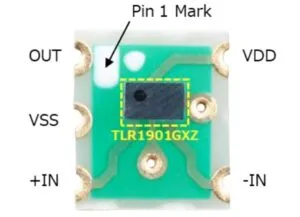TLR1901GXZ, as it will be known, is CMOS and has a maximum input offset voltage of 550μV (3Vdd 25°C), drifting at 7μV/°C.
Operation is across 1.7 to 5.5V and -40 to +85°C, and typical supply current is 160nA (at 3Vdd, 25°C, 280nA max).
“This IC is optimised to be applied as a measurement sensing amplifier in size-constrained applications such as handheld measurement instruments, wearable devices and indoor motion detectors,” said Rohm.
With such low current consumption, it is not a surprise that gain-bandwidth product is down at 400Hz (20dB, 25pF load), and slew rate is only 300V/s.
CMRR (common-mode rejection ratio) is a minimum of 60dB (100dB typ) and minimum PSRR (power supply RR) is 70dB (100dB typ).
The five-pad XCSP30L1 package is 0.33mm tall and has a 0.35mm ball pitch, and the company two micro resistor series: MCR004 (0402, 01005 inch, E suffix = Pb-free) and MCR006 (0603 – 0201 inch).
Typical output drive is ~3mA, restricted further by the package’s 489°C/W thermal resistance when mounted on a PCB.
 For development, what is possibly the smallest evaluation board ever is available for the op-amp, as the TLR1901GXZ-EVK-001 measures 2.4 x 2.9mm and fits onto a SSOP5 footprint.
For development, what is possibly the smallest evaluation board ever is available for the op-amp, as the TLR1901GXZ-EVK-001 measures 2.4 x 2.9mm and fits onto a SSOP5 footprint.
Find the TLR1901GXZ on this Rohm product page
Inside such a package there is limited room for ESD protection and, sadly, the data sheet does not include any electrostatic discharge tolerance information beyond saying: “this product is electrostatic sensitive”. Electronics Weekly has asked for more information, so watch this space if this is important to you.
And, if op-amps are important to you, take a look at this 110V 1A digitally-controlled monster from Analog Devices

